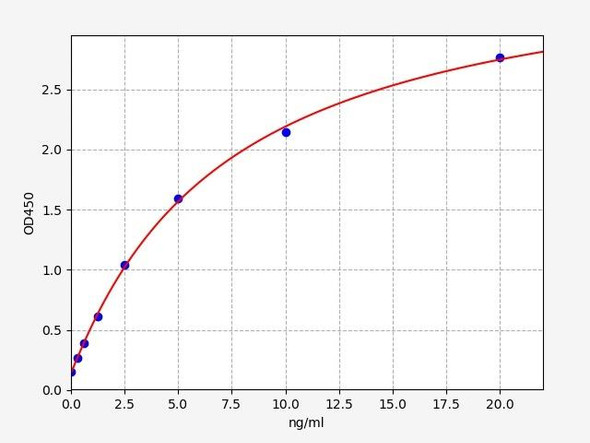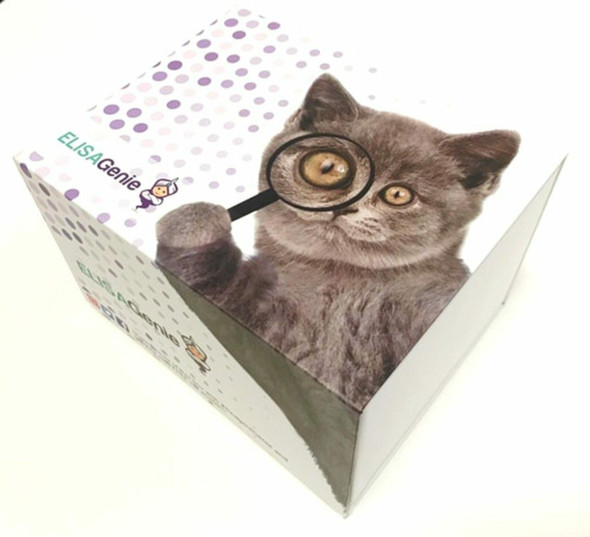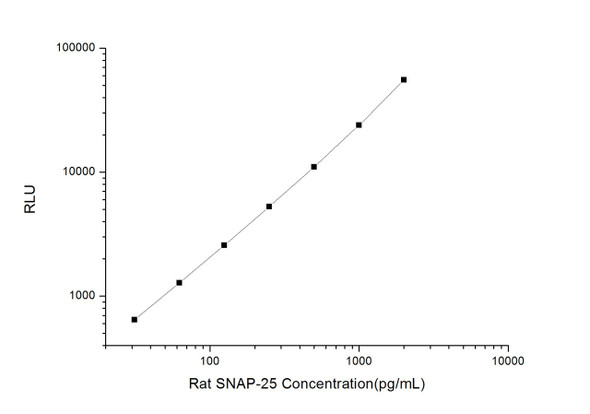Rat Synaptosomal-associated protein 25 (Snap25) ELISA Kit (RTEB1068)
- SKU:
- RTEB1068
- Product Type:
- ELISA Kit
- Size:
- 96 Assays
- Uniprot:
- P60881
- ELISA Type:
- Sandwich
- Synonyms:
- SNAP25, Synaptosomal-associated protein 25, SNAP-25, Super protein, SUP, Synaptosomal-associated 25 kDa protein, SNAP, RIC4, SEC9, SNAP, RIC-4, SNAP-25
- Reactivity:
- Rat
Description
Rat Synaptosomal-associated protein 25 (Snap25) ELISA Kit
The Rat Synaptosomal-Associated Protein 25 (SNAP25) ELISA Kit is a highly sensitive and specific assay designed for the accurate quantification of SNAP25 levels in rat samples, including serum, plasma, and cell culture supernatants. This kit provides reliable and reproducible results, making it an ideal tool for a variety of research applications.SNAP25 is a critical protein involved in synaptic transmission and vesicle fusion, playing a key role in neurotransmitter release. Dysregulation of SNAP25 has been linked to various neurological disorders, making it a valuable biomarker for studying these conditions and potentially developing therapeutic interventions.
With its high sensitivity and specificity, the Rat SNAP25 ELISA Kit offers a comprehensive solution for researchers looking to investigate the role of SNAP25 in neurological function and disease. Order your kit today from Assay Genie to advance your research efforts in this important area of study.
| Product Name: | Rat Synaptosomal-associated protein 25 (Snap25) ELISA Kit |
| SKU: | RTEB1068 |
| Size: | 96T |
| Target: | Rat Synaptosomal-associated protein 25 (Snap25) |
| Synonyms: | Super protein, Synaptosomal-associated 25 kDa protein, SUP, SNAP-25, Snap |
| Assay Type: | Sandwich |
| Detection Method: | ELISA |
| Reactivity: | Rat |
| Intra CV: | 4.3% | ||||||||||||||||||||
| Inter CV: | 7.5% | ||||||||||||||||||||
| Linearity: |
| ||||||||||||||||||||
| Recovery: |
| ||||||||||||||||||||
| Function: | t-SNARE involved in the molecular regulation of neurotransmitter release. Modulates the gating characteristics of the delayed rectifier voltage-dependent potassium channel KCNB1 in pancreatic beta cells (PubMed:12403834). May play an important role in the synaptic function of specific neuronal systems. Associates with proteins involved in vesicle docking and membrane fusion. Regulates plasma membrane recycling through its interaction with CENPF. |
| Uniprot: | P60881 |
| Sample Type: | Serum, plasma, tissue homogenates, cell culture supernates and other biological fluids |
| Specificity: | Natural and recombinant rat Synaptosomal-associated protein 25 |
| Sub Unit: | Part of the SNARE core complex containing SNAP25, VAMP2 and STX1A; this complex binds CPLX1 (PubMed:9759724, PubMed:12496247). Found in a complex containing SYT1, SV2B and syntaxin-1 (By similarity). Found in a ternary complex with STX1A and VAMP8 (PubMed:10336434). Isoform 1 and isoform 2 interact with BLOC1S6 (By similarity). Interacts with CENPF (By similarity). Interacts with EQTN (By similarity). Interacts with HGS (PubMed:9039916). Interacts with KCNB1 (via N-terminus); reduces the voltage-dependent potassium channel KCNB1 activity in pancreatic beta cells (PubMed:12403834). Interacts with OTOF (By similarity). Interacts with RIMS1 (PubMed:11438518). Interacts with SNAPIN (By similarity). Interacts with STXBP6 (PubMed:12145319). Interacts with TRIM9 (By similarity). Interacts with ZDHHC13 (via ANK repeats) (PubMed:26198635). Interacts with ZDHHC17 (via ANK repeats) (PubMed:26198635). Associates with the BLOC-1 complex. |
| Research Area: | Signal Transduction |
| Subcellular Location: | Cytoplasm Perinuclear region Cell membrane Lipid-anchor Cell junction Synapse Synaptosome Cell membrane Membrane association requires palmitoylation. Expressed throughout cytoplasm, concentrating at the perinuclear region (By similarity). Colocalizes with KCNB1 at the cell membrane (PubMed:12403834). |
| Storage: | Please see kit components below for exact storage details |
| Note: | For research use only |
| UniProt Protein Function: | SNAP-25: a presynaptic plasma membrane protein involved in the regulation of neurotransmitter release. May play an important role in the synaptic function of specific neuronal systems. Part of the SNARE core complex containing SNAP25, VAMP2 and syntaxin 1A. Associates with proteins involved in vesicle docking and membrane fusion. Two alternatively spliced isoforms have been described. |
| UniProt Protein Details: | Protein type:Vesicle Cellular Component: voltage-gated potassium channel complex; neuron projection; cell; terminal button; intracellular organelle; trans-Golgi network; cytosol; actin cytoskeleton; lipid raft; SNARE complex; growth cone; cell soma; membrane; lamellipodium; axon; perinuclear region of cytoplasm; cytoplasm; plasma membrane; synapse; cell junction; vesicle; myelin sheath; endosome; filopodium Molecular Function:SNAP receptor activity; protein domain specific binding; voltage-gated potassium channel activity; protein binding; SNARE binding; myosin binding; syntaxin-1 binding; protein N-terminus binding; calcium-dependent protein binding Biological Process: synaptic vesicle fusion to presynaptic membrane; growth hormone secretion; exocytosis; axonogenesis; long-term memory; regulation of synaptogenesis; neurotransmitter secretion; calcium ion-dependent exocytosis of neurotransmitter; positive regulation of hormone secretion; positive regulation of insulin secretion; endosome transport; sleep; synaptic vesicle priming |
| NCBI Summary: | Synaptic vesicle membrane docking and fusion is mediated by SNAREs (soluble N-ethylmaleimide-sensitive factor attachment protein receptors) located on the vesicle membrane (v-SNAREs) and the target membrane (t-SNAREs). The assembled v-SNARE/t-SNARE complex consists of a bundle of four helices, one of which is supplied by v-SNARE and the other three by t-SNARE. For t-SNAREs on the plasma membrane, the protein syntaxin supplies one helix and the protein encoded by this gene contributes the other two. Therefore, this gene product is a presynaptic plasma membrane protein. It is essential for regulated exocytosis in neuronal cells. Alternative transcript variants encoding two different protein isoforms have been described for this gene. [provided by RefSeq, Jul 2012] |
| UniProt Code: | P60881 |
| NCBI GenInfo Identifier: | 396080316 |
| NCBI Gene ID: | 25012 |
| NCBI Accession: | NP_001257505.1 |
| UniProt Secondary Accession: | P60881,P13795, P36974, P70557, P70558, Q8IXK3, Q96FM2 Q9BR45, |
| UniProt Related Accession: | P60881 |
| Molecular Weight: | |
| NCBI Full Name: | synaptosomal-associated protein 25 isoform a |
| NCBI Synonym Full Names: | synaptosomal-associated protein 25 |
| NCBI Official Symbol: | Snap25 |
| NCBI Official Synonym Symbols: | SNAP-25B; SNAP-25a |
| NCBI Protein Information: | synaptosomal-associated protein 25; SUP; SNAP-25; super protein; synaptosomal-associated 25 kDa protein; synaptosomal-associated protein, 25 kDa |
| UniProt Protein Name: | Synaptosomal-associated protein 25 |
| UniProt Synonym Protein Names: | Super protein; SUP; Synaptosomal-associated 25 kDa protein |
| Protein Family: | Synaptosomal-associated protein |
| UniProt Gene Name: | Snap25 |
| UniProt Entry Name: | SNP25_RAT |
| Component | Quantity (96 Assays) | Storage |
| ELISA Microplate (Dismountable) | 8×12 strips | -20°C |
| Lyophilized Standard | 2 | -20°C |
| Sample Diluent | 20ml | -20°C |
| Assay Diluent A | 10mL | -20°C |
| Assay Diluent B | 10mL | -20°C |
| Detection Reagent A | 120µL | -20°C |
| Detection Reagent B | 120µL | -20°C |
| Wash Buffer | 30mL | 4°C |
| Substrate | 10mL | 4°C |
| Stop Solution | 10mL | 4°C |
| Plate Sealer | 5 | - |
Other materials and equipment required:
- Microplate reader with 450 nm wavelength filter
- Multichannel Pipette, Pipette, microcentrifuge tubes and disposable pipette tips
- Incubator
- Deionized or distilled water
- Absorbent paper
- Buffer resevoir
*Note: The below protocol is a sample protocol. Protocols are specific to each batch/lot. For the correct instructions please follow the protocol included in your kit.
Allow all reagents to reach room temperature (Please do not dissolve the reagents at 37°C directly). All the reagents should be mixed thoroughly by gently swirling before pipetting. Avoid foaming. Keep appropriate numbers of strips for 1 experiment and remove extra strips from microtiter plate. Removed strips should be resealed and stored at -20°C until the kits expiry date. Prepare all reagents, working standards and samples as directed in the previous sections. Please predict the concentration before assaying. If values for these are not within the range of the standard curve, users must determine the optimal sample dilutions for their experiments. We recommend running all samples in duplicate.
| Step | |
| 1. | Add Sample: Add 100µL of Standard, Blank, or Sample per well. The blank well is added with Sample diluent. Solutions are added to the bottom of micro ELISA plate well, avoid inside wall touching and foaming as possible. Mix it gently. Cover the plate with sealer we provided. Incubate for 120 minutes at 37°C. |
| 2. | Remove the liquid from each well, don't wash. Add 100µL of Detection Reagent A working solution to each well. Cover with the Plate sealer. Gently tap the plate to ensure thorough mixing. Incubate for 1 hour at 37°C. Note: if Detection Reagent A appears cloudy warm to room temperature until solution is uniform. |
| 3. | Aspirate each well and wash, repeating the process three times. Wash by filling each well with Wash Buffer (approximately 400µL) (a squirt bottle, multi-channel pipette,manifold dispenser or automated washer are needed). Complete removal of liquid at each step is essential. After the last wash, completely remove remaining Wash Buffer by aspirating or decanting. Invert the plate and pat it against thick clean absorbent paper. |
| 4. | Add 100µL of Detection Reagent B working solution to each well. Cover with the Plate sealer. Incubate for 60 minutes at 37°C. |
| 5. | Repeat the wash process for five times as conducted in step 3. |
| 6. | Add 90µL of Substrate Solution to each well. Cover with a new Plate sealer and incubate for 10-20 minutes at 37°C. Protect the plate from light. The reaction time can be shortened or extended according to the actual color change, but this should not exceed more than 30 minutes. When apparent gradient appears in standard wells, user should terminatethe reaction. |
| 7. | Add 50µL of Stop Solution to each well. If color change does not appear uniform, gently tap the plate to ensure thorough mixing. |
| 8. | Determine the optical density (OD value) of each well at once, using a micro-plate reader set to 450 nm. User should open the micro-plate reader in advance, preheat the instrument, and set the testing parameters. |
| 9. | After experiment, store all reagents according to the specified storage temperature respectively until their expiry. |
When carrying out an ELISA assay it is important to prepare your samples in order to achieve the best possible results. Below we have a list of procedures for the preparation of samples for different sample types.
| Sample Type | Protocol |
| Serum | If using serum separator tubes, allow samples to clot for 30 minutes at room temperature. Centrifuge for 10 minutes at 1,000x g. Collect the serum fraction and assay promptly or aliquot and store the samples at -80°C. Avoid multiple freeze-thaw cycles. If serum separator tubes are not being used, allow samples to clot overnight at 2-8°C. Centrifuge for 10 minutes at 1,000x g. Remove serum and assay promptly or aliquot and store the samples at -80°C. Avoid multiple freeze-thaw cycles. |
| Plasma | Collect plasma using EDTA or heparin as an anticoagulant. Centrifuge samples at 4°C for 15 mins at 1000 × g within 30 mins of collection. Collect the plasma fraction and assay promptly or aliquot and store the samples at -80°C. Avoid multiple freeze-thaw cycles. Note: Over haemolysed samples are not suitable for use with this kit. |
| Urine & Cerebrospinal Fluid | Collect the urine (mid-stream) in a sterile container, centrifuge for 20 mins at 2000-3000 rpm. Remove supernatant and assay immediately. If any precipitation is detected, repeat the centrifugation step. A similar protocol can be used for cerebrospinal fluid. |
| Cell culture supernatant | Collect the cell culture media by pipette, followed by centrifugation at 4°C for 20 mins at 1500 rpm. Collect the clear supernatant and assay immediately. |
| Cell lysates | Solubilize cells in lysis buffer and allow to sit on ice for 30 minutes. Centrifuge tubes at 14,000 x g for 5 minutes to remove insoluble material. Aliquot the supernatant into a new tube and discard the remaining whole cell extract. Quantify total protein concentration using a total protein assay. Assay immediately or aliquot and store at ≤ -20 °C. |
| Tissue homogenates | The preparation of tissue homogenates will vary depending upon tissue type. Rinse tissue with 1X PBS to remove excess blood & homogenize in 20ml of 1X PBS (including protease inhibitors) and store overnight at ≤ -20°C. Two freeze-thaw cycles are required to break the cell membranes. To further disrupt the cell membranes you can sonicate the samples. Centrifuge homogenates for 5 mins at 5000xg. Remove the supernatant and assay immediately or aliquot and store at -20°C or -80°C. |
| Tissue lysates | Rinse tissue with PBS, cut into 1-2 mm pieces, and homogenize with a tissue homogenizer in PBS. Add an equal volume of RIPA buffer containing protease inhibitors and lyse tissues at room temperature for 30 minutes with gentle agitation. Centrifuge to remove debris. Quantify total protein concentration using a total protein assay. Assay immediately or aliquot and store at ≤ -20 °C. |
| Breast Milk | Collect milk samples and centrifuge at 10,000 x g for 60 min at 4°C. Aliquot the supernatant and assay. For long term use, store samples at -80°C. Minimize freeze/thaw cycles. |










